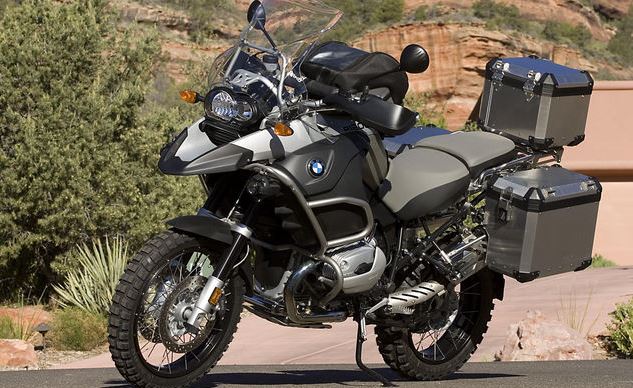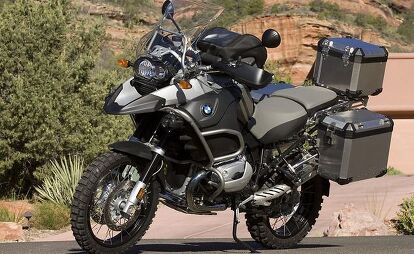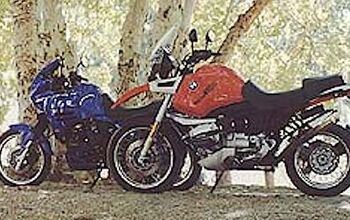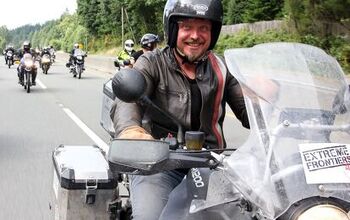Church Of MO – 2006 BMW R 1200 GS Adventure

Next week your intrepid MO crew is embarking on an epic Adventure-Touring ride with nine – yes, nine – of the biggest and baddest A-T bikes in the segment. Over the next six days the nine bikes and riders will cover 2000 miles over various terrain. Each bike will be put to the test in what will be one of MO’s largest-ever comparison tests. We won’t give away all the bikes taking part in the test just yet, but you can likely guess some of the obvious choices. One of them being the BMW R1200GS. So for this Church feature, we look back at the 2006 BMW R1200GS Adventure. Lending his words is former MOron, Pete Brissette, who will be joining the MO crew as a special guest tester for next week’s epic ride. Lastly, be sure to check out the photo gallery for even more pics of the 2006 GS Adventure. Take it away, Pete…
2006 BMW R 1200 GS Adventure
By Pete Brissette Jun. 12, 2006
Photos by Kevin Wing
The word “adventure” evokes a variety of different emotions depending on who you are. For the motorcyclist, that word can’t be used without self-aggrandizing images of successfully circumnavigating the globe coming to mind. Perhaps in your mind’s eye you narrowly escaped a swollen river crossing in some remote, South American jungle. Or maybe you triumphantly conquered the unforgiving heat and sands of the Egyptian deserts while en route to Cairo. You might be the competitive, Type-A motorcyclist who cerebrates of competing in the Paris-Dakar or Baja 1000.
Any cyclist who is honest with themselves has to admit that those images have tickled their imagination at least once. No manufacturer has been able to capitalize on such mental wanderings of the motorcycle enthusiast quite like BMW. It has only been recently that other makers have entered and attempted to topple BMW’s strangle hold on a very small segment of the motorcycle world, informally known as adventure touring. Beginning with the R80 G/S, BMW created a whole new breed of motorbike specifically suited for on and off road riding(hence the S for street or strasseand the G for off road or gelände);the G/S (or GS line as it became known) has become an icon for two-wheeled exploits the world over.
To let the motorcycle press realize the potential (or at least a fraction thereof) that this latest GS is capable of, BMW invited a handful of us to Sedona, Arizona; a perfect backdrop for a bike like the GS. But before we were unleashed upon the dusty red desert, the BMW staff let us in on the differences between this bike and its-lesser adorned brother.
One of the most visually obvious differences is the larger fuel tank. Boasting a capacity of 8.7 gallons and a theoretical range of over 400 miles (should you be able to maintain 56 mph), the Adventure carries 3.4 gallons more petrol than the standard R 1200 GS. Next up are the two additional flaps behind the extra-large windscreen (located just behind the screen and flanking the instrument cluster area) which are said to help reduce buffeting in the “kidney area.” By most accounts, it seems to work. Following the function-over-form philosophy are the tank/engine/valve cover crash guards. Figuring that anyone purchasing a GS is probably inclined to carry a thing or two, a stainless steel luggage rack is bolted on. Presumably, a potential GS owner will want to add the optional, if pricey hard panniers and top box that will integrate nicely with said luggage rack. A two piece, adjustable seat comes on the hopped-up GS which allows the rider to lower the seat from its level (with the rear section) 36 inch position to a 35.2 inch saddle height. Standard on the Adventure but optional on the “regular” GS are hand protectors that are attached to an aluminum handlebar.
An extra 0.8 of an inch of travel has been added, for a total of 8.7 inches at the rear and 8.3 inches up front. Attached to those suspenders are the much esteemed cross-spoke wheels. Being adaptable is a hallmark of the Adventure, and to that end the gear shift and foot brake are adjustable via an eccentric pivot and a folding spacer, respectively. While in the vicinity of the gear shift and foot brake you’ll find much wider footrests, and thanks to a modified rear frame the side and center stands are relocated and easier to use. Last, but most certainly not least, is the high-output 720 watt alternator. It’s a full 120 watts more than the standard version’s 600 watts. Auxiliary lighting, here we come.
Although most of the disparities between the standard GS and the Adventure are primarily aimed towards convenience and comfort, greater are the changes from the original Adventure model variation found on the R 1150 GS. In 2004, as most everyone should know by now, the base GS increased from an 1150 to a 1200, but the Adventure version did not change until 2006.
Starting with the heart of the beast, BMW claims a 15 percent increase in horsepower over the previous Adventure, giving the updated model 100 hp at 7,000 rpm. Torque peaks at a claimed 85 ft. lbs at 5,500 rpm. The Beemer does this by increasing the stroke to 73mm while the bore remains at 101mm, which ultimately increases displacement to 1,170 cc, up from 1,150 cc. The compression ratio increases from 10.3:1 to 11.0:1.
The “biggest news surrounding the R 1200 GS’s new engine”, according to BMW press material, is the gear-driven counter balancer. They claim this is the first time such technology has ever been used in one of their opposed-twin engines, all done in the name of smoothness. Additional revamps to the old 1150 mill include a two-spark-plug-per-cylinder set-up, a new engine management system, a new EVO-Paralever and Telelever suspension system, and a six-speed transmission. The end result is a GS Adventure model that is more powerful than the previous Adventure and 27 pounds lighter.
To discover just how pleasurable it can be to have all the luxuries found on this decked-out GS, BMW saw fit to map out an exceptional 200 plus-mile ride that began on a wide, well-maintained gravel road that allowed us to acclimate to the varied terrain we would encounter later. After realizing that speeds usually attempted on paved surfaces could be attained just as easily in the dirt, we would find ourselves droning comfortably as freeway mile after freeway mile clicked off as our first paved section presented itself. Then it was back to more loose gravel roads that seemed to stretch endlessly into the horizon; that is if you could see the horizon through the nearly impenetrable dust cloud that the other riders generated..
The day’s ride continued to alternate between pavement and no pavement; at one point we were able to test the GS’s handling manners when a twisting ribbon of black greeted us after a long stretch of dirt and grime. In my opinion, the GS is better-behaved at speed while carving paved twists and turns of varying degrees of radius, than many street-only bikes I’ve ridden. Frame flex was minimal and despite the fact that this bike has substantial suspension travel, it never caused the bike to wallow while cornering at high speeds. Trail braking also failed to completely upset the chassis to the point where full deceleration seemed the only option. At least two other journalists agreed with me that harassing street bikes in the canyons while mounted on the GS would be child’s play, especially with the smooth-tread street tire that’s available. One journo even mocked that it could easily be done while riding two-up.
A special lunch stop awaited those of us who opted to take the plunge, so to speak. After continuing on yet another dirty road, the surrounding views became mysteriously familiar.
Even though I had never spent anytime in Arizona, I soon realized that we were in fact riding into the Grand Canyon, something that rarely happens, according to many Canyon veterans with us that day. Not only were we beginning to see the magnificent water-carved canyon walls that so many have only seen on television or post cards, we were about to ride to the edge of the Colorado river for our lunch stop. The remaining mile and a half or so of road continued to degenerate into a wash rather than something resembling a roadway. For those of us who chose to solider on, we were now committed to picking our way through a stream that had long since reclaimed the land. With medium to large algae-covered rocks and several inches of water as the route to the river’s edge, I somehow found time to day dream about how I could do this type of riding all over the World while I scanned the surfaces ahead for a dry and level patch of land as a momentary reprieve, ensuring to never lose my momentum lest I tip over.
In what was probably far less time than what I perceived it to be, we arrived one by one to the lunch stop for a much-needed rest and time to contemplate what we had all just accomplished. With the bikes partially refueled (as well as our bellies) we mounted up and headed out from the river to get back on schedule. This of course meant that it was one way in and one way out. “Gee, do we have to ride through that same challenging terrain again? Really? What a shame.”
The final leg of our journey was nothing less than an hour’s worth of all dirt roads. Often times the road was what could only be described as a gravel highway. But as we approached our destination, that same road quickly became more narrow, more contorted, more unforgiving in its surface and generally more dangerous. More dangerous due mostly to speeds that I would have thought I would only have seen unless I participated in the Baja 1000 that was taking place in my head. The less-than-sane speeds that I exploited on the dirt roads throughout the ride had the bike drifting and sliding around corners, and even on the straight and narrow. But thanks to the low center of mass and increased suspension travel, I was always in control, even when out of control, if that makes sense.
Indeed, the scenes actually playing out before me with the riders ahead whipping up massive tails and clouds of thick dust as we rode into the sunset over the flat horizon, gave me visions of my own Dust to Glory story. To draw you back into reality for just a moment, the qualities and characteristics of the GS Adventure remain largely the same as the R 1200 GS which we covered more in-depth in last year’s adventure touring shootout and the individual test of the bike. What I can say about the bike–that the day’s ride allowed me to further discover–was the way that it made such riding so relatively easy, even though I could write the sum total of my off-road experience on the back of a postage stamp with room to spare. This was true of a number of other attendees and yet we all had the same experience; we were all able to complete each portion of the ride successfully and with confidence. At risk of sounding like a braggart, I ultimately found myself in the “advanced” riding group near day’s end. Not a testament to my abilities or skills, but to the Adventure’s accessibility to anyone willing to ride it. BMW had also invited guests with immeasurably more off-road riding talents than myself, and they agreed that one of the traits of the GS is its ability to make adventure riding seem easier than it is. My ego swelled later in the evening as a well-respected editor said to me, “Man, you were really flying at the end.”
A good part of this can be attributed to the superb Paralever and Telelever suspension, the rather wise use of a 17 inch rear and 19 inch front wheel combination (another journalist noted that, a different bike with a more traditional dirt bike-sized tire up front wouldn’t have allowed for such successful riding by the less-experienced among us), the smooth fuel injection, powerful but sensitive brakes, light clutch action combined with a trouble-free transmission and a well-balanced package. I give credit to the ease with which the bike can be manipulated, to the low center of gravity inherent in the boxer configuration.
Ultimately, no machine is perfect, and a few minor, items need to be noted. Of most concern to most people is the tall saddle height due to the long suspension travel. Standing 5’8″, I was able to overcome the challenge but many that day weren’t so lucky. More than one bike was tipped over in a parking lot dismount or slow-speed maneuver through rough terrain. The saddle was a touch on the firm side, especially for longer freeway jaunts. But that’s where the over-sized footrests come in handy. Where a little additional riding leverage is needed or just a change of position, simply standing up on the pegs can be a welcome change. Others complained, that when adjusted to its highest position, the large windscreen was distracting to look through, making them wish they were looking over it instead. Short of those few remarks, my admittedly limited dirt riding expertise makes it difficult to dissect any nuances to the point that they would be a useful consideration.
The R 1200 GS, like all Beemers, is prepped to receive a large variety of accessories offered by BMW. With a base price of $16,600.00, there’s plenty of room to grow that figure rather quickly considering the list of options available, many of which are the same on BMW motorcycles. Before you bolt all those accessories on, BMW says the GS Adventure will weigh 492 lbs dry and 564 lbs wet.
Finally, to return to my regaling of the ride, what lay at the end of that glorious red road was the South Rim of the Grand Canyon. Never having been to the Canyon, I couldn’t think of a better way to end such an incredible ride on a bike so well-suited to just such an adventure.
If you go…
If you find yourself on any kind of adventure in or around Sedona–two-wheeled or otherwise–be sure to go a little bit out of your way and stop by Jerome, Arizona. Located high atop a hill, between Prescott and Flagstaff, Jerome was once a copper mining town with the reputation as the “wickedest town in the west.” Today Jerome is a haven for eclectic artist types and tourism is its mainstay. But don’t just go there to buy “Indian” jewelry. You absolutely must visit the Gold King Mine and Ghost Town. With “Don” as your guide, you’ll find yourself in awe of the innumerable collections of rusty old tools, parts to anything and dilapidated trucks and cars, some of which still run. Although quite lucid, Don looks the part of a desperate old prospector.
To my mind, the most worthwhile attraction is “Big Bertha.” Once the primary source of power for the mining town, Big Bertha is a three-cylinder generator. She’s now partly disassembled since she doesn’t need to provide anything other than laughs. For the sum of $10.00, Don will fire-up the old, stationary tractor that is used to, well, start the starter on the generator. Once rolling, Big Bertha sucks in a huge volume of air with such ferocity that you can hear it “breathe.” As an added surprise Don will fiddle with the compression release, causing Big Bertha to backfire with enough force to send anyone who hasn’t heard her, run for cover. If you’re a true gear head or just someone who likes the old and weird, be sure to visit Gold King Mine and Ghost Town. It’s well worth the time spent. http://www.goldkingmine.net/
| ** Specifications Courtesy of BMW ** R 1200 GS Adventure – MSRP: $16,600 | |
| Engine | |
| Type | Air-cooled/oil-cooled Boxer twin-cylinder |
| Displacement | 1170 cc |
| Bore X Stroke | 101.0 mm x 73.0 mm |
| *Claimed* Horsepower | 100 bhp @ 7000 rpm |
| *Claimed* Torque | 85 lb/ft @ 5500 rpm |
| Valve Gear | Chain-driven, high cam, OHV, w/adj. rocker arms |
| No of cylinders | 2 |
| Compression Ratio | 11.0:1 |
| Engine Management | BMW Engine Controller – BMS K |
| Valves per Cylinder | Four |
| Valves | 2 x 36 mm intake / 2 x 31 mm exhaust |
| Fuel Tank | HDPE, internal pump and internal filter |
| Alternator W | 720 Watts @ 14 Volts |
| Battery V/AH | 12 Volts / 14 Amps/hour |
| Engine Summary | The two cylinder flat twin Boxer engine is BMW’s famous, time-tested, signature design. First designed in 1923, its two horizontally mounted cylinders are like a boxer’s gloves punching each other as he enters the ring. The result is a supremely reliable, flexible engine with a low center of gravity and like all twins, excellent torque characteristics. The exposed cylinders offer excellent air cooling and if it’s durability, performance, and bulletproof all-around handling you want, this is your powerplant. |
| Drivetrain | |
| Clutch | 180 mm dry, single plate with hydraulic actuation |
| Gear Box | 6 speed gear box |
| Primary Transmission | 1:1.823 |
| Gear Ratios | I: 2.28:1 II: 1.58:1 III: 1.26:1 IV: 1.03:1 V: 0.90:1 VI: 0.81:1 |
| Final Drive System | Enclosed driveshaft with two universal joints |
| Final Drive Ratio | 2.82:1 |
| Frame & Suspension | |
| Frame | Three-part, engine/cast aluminum/tubular steel |
| Front wheel suspension | BMW Telelever |
| Rear wheel suspension | BMW EVO Paralever |
| Spring Travel front/rear | 8.3 inches / 8.7 inches |
| Ground Clearance | N/A |
| Handlebar center point angle | 63.8 degrees |
| Brakes | |
| Brake System | BMW EVO with partial integral ABS |
| Front Brakes | Two, four-piston fixed calipers |
| Front Rotor | 12.0 inch dual floating rotors |
| Rear Brakes | Single, two-piston floating caliper |
| Rear Rotor | 10.4 inch single, fixed rotor |
| Actuation | Hydraulic, DOT 4 fluid type |
| Wheels & Tires | |
| Front Wheel | 2.50 x 19 cross-spoke |
| Rear Wheel | 4.00 x 17 cross-spoke |
| Front Tire | 110/80 x 19 tubeless |
| Rear Tire | 150/70 x 17 tubeless |
| Dimensions | |
| Overall Length | 88.6 inches |
| Overall Width | 37.6 inches |
| Wheelbase | 59.5 inches |
| Seat height | 35.2 inches |
| *Claimed* Weight, unladen, with full tank | 564 lbs |
| Max permissible weight | 1025 lbs |
| Fuel Capacity | 8.7 U.S. gallons including 1 gallon reserve |

Troy's been riding motorcycles and writing about them since 2006, getting his start at Rider Magazine. From there, he moved to Sport Rider Magazine before finally landing at Motorcycle.com in 2011. A lifelong gearhead who didn't fully immerse himself in motorcycles until his teenage years, Troy's interests have always been in technology, performance, and going fast. Naturally, racing was the perfect avenue to combine all three. Troy has been racing nearly as long as he's been riding and has competed at the AMA national level. He's also won multiple club races throughout the country, culminating in a Utah Sport Bike Association championship in 2011. He has been invited as a guest instructor for the Yamaha Champions Riding School, and when he's not out riding, he's either wrenching on bikes or watching MotoGP.
More by Troy Siahaan
















































Comments
Join the conversation